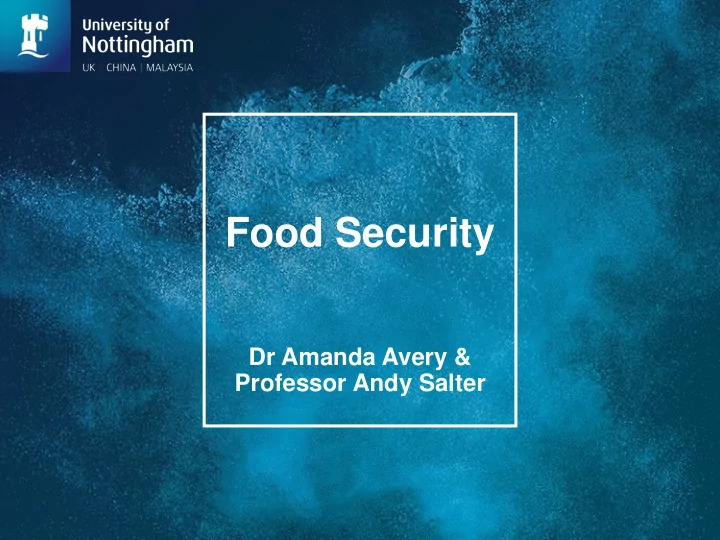

Food Security Dr Amanda Avery & Professor Andy Salter
Is food production, good nutrition and dietetic practice just about encouraging healthier eating practices? • Or does it embrace the wider social policies around sustainability, climate change and food security? • Should we focus just on what people eat or should we also consider how our food is produced, distributed and whether food is equally accessible and affordable? • Should we be supplementing our advice with encouragement to make sustainable food choices? • WHAT DO YOU THINK? – 10 minutes discussion in mini groups
What is Food Security? There are different ways to define food security. What it means is having food on the plate today and confidence that there will be food on the plate tomorrow, next week, next month and in years to come. But food security is about more than just ensuring that there will be food to eat tomorrow. There is little use having sufficient food available for tomorrow if it is going to cost more than a day’s wages or if it is spoilt by pests or dangerous pathogens. Food security includes: Availability: is there enough to go around? Access: can it be reached efficiently? Affordability: can it be bought at a fair price? Quality: is the food edible? Nutrition: is the food part of a balanced diet? Safety: could it harm health?
Is there a problem? If there is why is there a problem?
The problem • The world’s population is projected to increase from 6 to 9Bn by 2050 – including Africa’s population to double from 1 to 2Bn – the only continent that is not self-sufficient in food production. • Demand for food needs to increase by 40% by 2030 and 70% by 2050. The World Bank estimated that cereal production needs to increase by 50% and meat production by 85% between 2000 and 2030 to meet demand. • But while demand for food is rising, the amount of land suitable for food production is likely to decrease – mainly through pressures from other uses and climate change. • A review of food waste in the US calculated that 43Bn kg of food, just over a quarter of the amount available to consume, was lost from retailing onwards .
Food waste Is it a problem in the UK?
Household Food and Drink Waste data • The estimated amount of HHFW in the UK for 2015 was 7.3 million tonnes, compared to 7.0 million tonnes in 2012, an increase of 4.4%. On a per person basis, the apparent increase was 2.2%. Neither of these increases was statistically significant. • The amount of avoidable (i.e. the food that could have been eaten) HHFW in 2015 was 4.4 million tonnes, compared to 4.2 million tonnes in 2012 (an increase of 5.1%, or 2.8% on a per person basis). Again, neither of these increases was statistically significant. • Food with a retail value of around £13 billion was thrown away rather than being eaten in 2015. This avoidable HHFW was associated with 19 million tonnes of CO2e, which is equivalent to the emissions generated by 1 in 4 cars on UK roads.
www.wrap.org.uk
Need further clarification why we need to act? https://youtu.be/Q9XoWsmTc1o
So what can you do to reduce food waste (and save money)?
Other quick wins to help reduce the impact on the environment. Food is being transported longer and longer distances – FOOD MILES – from producer to consumer. In the UK, comparatively little of the food we consume comes from local producers; and much will have been transported over great distances. SO SOURCE LOCAL INGREDIENTS WHEREVER POSSIBLE
Finding alternative protein sources
Why?
Please contact us with any queries Andrew.salter@nottingham.ac.uk Amanda.avery@Nottingham.ac.uk
Recommend
More recommend